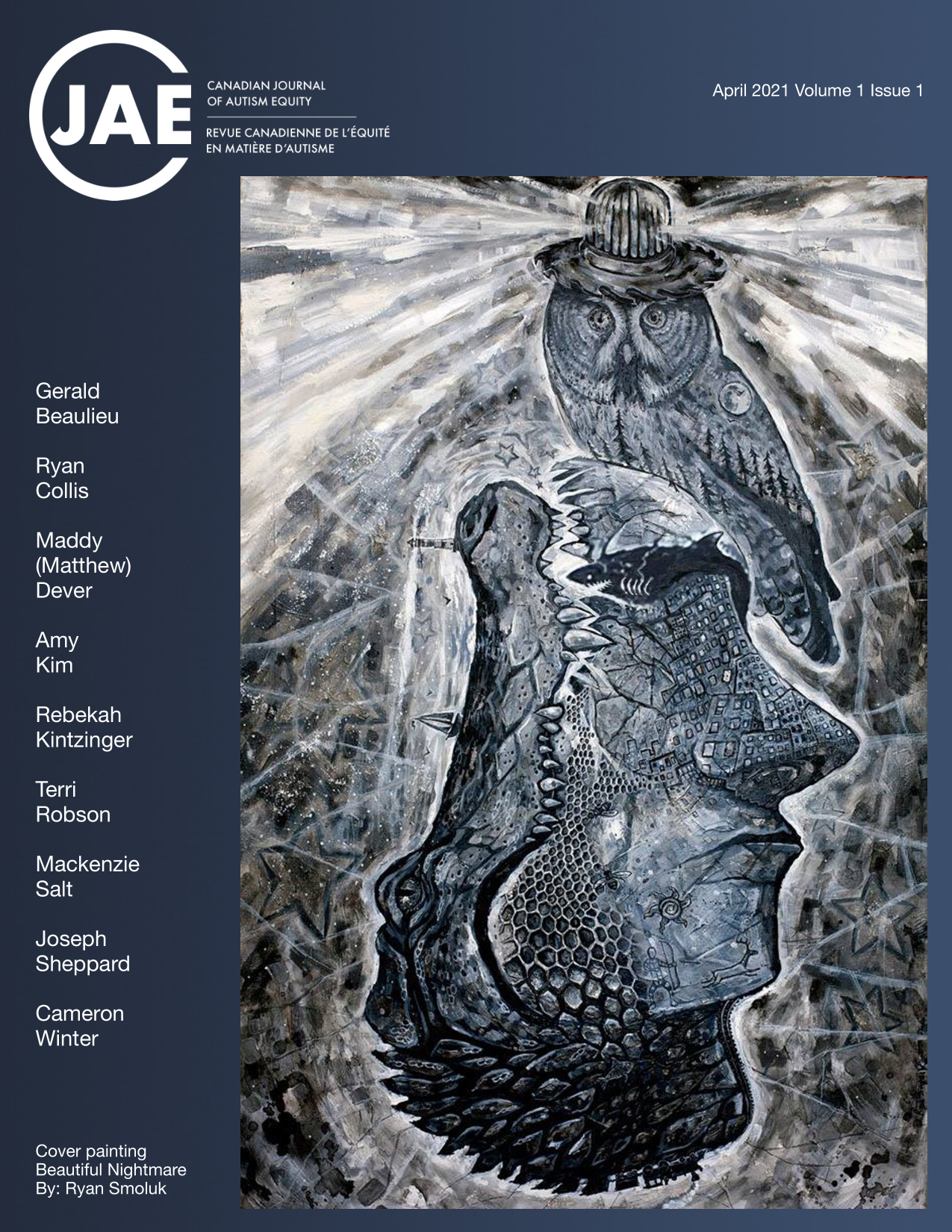Equity: What Model Should We Use When We Talk About Autism?
DOI:
https://doi.org/10.15173/cjae.v1i1.4982Keywords:
Autism, Disability Rights, AdvocacyAbstract
In the Canadian disability rights movement, with regards to autism specifically, there has been a shift towards recognizing what is called a social model of disability. Through this movement, there has been a desire to incorporate that model into practice in governments, institutions, and healthcare. This desire also stems from advocate-centric and first-voice communities, where disabilities like autism are not viewed through a deficit-based lens. This article aims to discuss the often polarizing social and medical models of disability, comparing their uses in the disability world while weighing their respective benefits. Finally, an alternative model of disability that intersects these models is discussed as an alternative. This model is called the International Classification of Functioning, which recognizes three levels that impair a disabled person: the body, the person, and the environment. It is from this focus that policy can be developed to answer the calls of the pan-disability movement; to provide equitable changes across services and domains that are rightly deserved for Autistic and disabled people.
References
Council of Canadians with Disabilities. (n.d.). History. http://www.ccdonline.ca/en/about/history
Anderson-Chavarria, M. (2021). The autism predicament: Models of autism and their impact on autistic identity. Disability & Society, 1-21. https://doi.org/10.1080/09687599.2021.1877117
Berghs, M., Atkin, K., Graham, H., Hatton, C., & Thomas, C. (2016). Scoping models and theories of disability. In Implications for public health research of models and theories of disability: A scoping study and evidence synthesis. NIHR Journals Library. https//www.ncbi.nom.gov/books/NBK378951/
Botha, M., Hanlon, J., & Williams, G. L. (2021). Does language matter? Identity-first versus person-first language use in autism research: A response to Vivanti. Journal of Autism and Developmental Disorders. https://doi.org/10.1007/s10803-020-04858-w
Bury, S. M., Jellett, R., Spoor, J. R., & Hedley, D. (2020). “It Defines Who I Am” or “It’s Something I Have”: What language do [Autistic] Australian adults [on the Autism Spectrum] prefer? Journal of Autism and Developmental Disorders. https://doi.org/10.1007/s10803-020-04425-3
Commonwealth Disabled People’s Forum. (n.d.) https://commonwealthdpf.org/
de Camargo, O. K., & Snyman, S. (2019). The ICF: Themes and tools for the education of health professionals. In ICF: A Hands-on Approach for Clinicians and Families (1st ed., p. 192).
Disability, W. in C. (DWC) S. C. (2019). Moving forward together: A pan-Canadian strategy for disability and work. 19.
Gesley, J. (2017). Germany: Act to strengthen the disabled’s participation in society enters into force. Global Legal Monitor, 2.
Kapp, S. K. (2019). How social deficit models exacerbate the medical model: Autism as case in point. Autism Policy and Practice, 26.
Lawson, A., & Beckett, A. E. (2021). The social and human rights models of disability: Towards a complementarity thesis. The International Journal of Human Rights, 25 https://doi.org/10.1080/13642987.2020.1783533
Ministry of Children, Community and Social Services. (2019, September 11). Ontario Autism Program.Ontario.Ca. https://www.ontario.ca/page/ontario-autism-program
Oliver, M. (2013). The social model of disability: Thirty years on. Disability & Society, 28(7), 1024–1026. https://doi.org/10.1080/09687599.2013.818773
Samaha, A. M. (2007). What good is the social model of disability? The University of Chicago Law Review, 74(4), 1251. https://doi.org/10.2307/20141862
Shyman, E. (2016). The reinforcement of ableism: Normality, the medical model of disability, and humanism in applied behavior analysis and ASD. Intellectual and Developmental Disabilities, 54(5), 366–376. https://doi.org/10.1352/1934-9556-54.5.366
Singh, J. S. (2016). Parenting work and autism trajectories of care. Sociology of Health & Illness, 38(7), 1106–1120. https://doi.org/10.1111/1467-9566.12437
Stewart, D., & Rosenbaum, P. (2003). The International Classification of Functioning, Disability, and Health (ICF): A global model to guide clinical thinking and practice in childhood disability. CanChild. https://canchild.ca/en/resources/182-the-international-classification-of-functioningdisability-and-health-icf-a-global-model-to-guide-clinical-thinking-and-practice-in-childhooddisability
Üstün, T. B. (n.d.). The ICF: An overview. World Health Organization. https://www.cdc.gov/nchs/data/icd/icfoverview_finalforwho10sept.pdf
Yañez, M. (2019). Implementation of ICF in Mexico. WHO Collaborating Centre Voor de Familie van Internationale Classificaties (FIC) in Nederland. https://whofic.nl/implementation-of-icf-in-mexico
Zolyomi, A., Begel, A., Waldern, J. F., Tang, J., Barnett, M., Cutrell, E., McDuff, D., Andrist, S., & Morris, M. R. (2019). Managing stress: The needs of Autistic adults in video calling. Proceedings of the ACM on Human-Computer Interaction, 3(CSCW), 1–29. https://doi.org/10.1145/3359236
Downloads
Published
How to Cite
Issue
Section
License
Copyright (c) 2021 Rebekah Kintzinger

This work is licensed under a Creative Commons Attribution-NonCommercial-ShareAlike 4.0 International License.
Authors retain copyright and grant the journal the right of first publication with the work simultaneously licensed under a Creative Commons Attribution License that allows others to share the work with an acknowledgement of the work's authorship and initial publication in this journal.
Authors are able to enter into separate, additional contractual arrangements for the non-exclusive distribution of the journal's published version of the work (e.g., post it to an institutional repository or publish it in a book), with an acknowledgement of its initial publication in this journal.
CJAE accepts articles that have not been published in any other journals/proceedings, unless copyright permission is assured, and have not been submitted for consideration to any other journals/proceedings at the time of submitting to the Canadian Journal of Autism Equity for consideration. While a paper is under consideration by CJAE, you agree not to submit the work to other journals/proceedings until review by CJAE is completed and a decision has been rendered.



